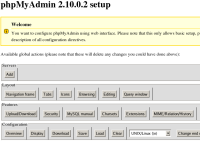Installing phpMyAdmin 2.8
Installation
Get the latest version of phpMyAdmin from phpMyAdmin.net. The files will compressed - so you will have to extract it. Create a folder called 'phpMyAdmin' in the document root of your server and extract the PHP scripts into it. That's it - the installing part is over. The latest version will automatically configure itself to run with these settings...
- Database Host : localhost
- Username : root
- Password : (Empty)
Configuration

If you wish to configure your phpMyAdmin using more advanced options, open the folder you installed phpMyAdmin to(<Document Root/phpMyAdmin/>) and create a folder called 'config'. Make sure it has write permission. You can give it write permission with the following command(assuming that your are on a linux system)...
chmod 666 config
Using the Setup Script
Now open the URL http://localhost/phpMyAdmin/scripts/setup.php. This will help you configure your phpMyAdmin.
Servers
First, we need to add a Database server - click on the 'Add' button in the 'Servers' fieldset. This will open up an interface into which you can enter the details of the server. You have to enter at least these three values...
- Server hostname
- The MySQL Server address. Eg. localhost
- User for config auth
- Database User. Eg. root
- Password for config auth
- Password for the above given user. Eg. password
One option to be careful about is the 'Authentication type'. By default, this is set to 'config'. That means that the username and the password will be stored in the config file. So, anyone who knows the URL to the phpMyAdmin installation, will be able to access the database. This is great in a local system - but is a huge vulnerability in a production system.
config.inc.php
After you have finished configuration, click on the 'Save' Button in the 'Configuration' section. This will create a 'config.inc.php' file inside the 'config' folder that we created earlier. You will have to manually copy this config file to you phpMyAdmin folder. After this is done, delete the config folder. You can do this with the command...
mv config/config.inc.php . rmdir config
